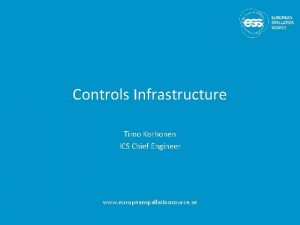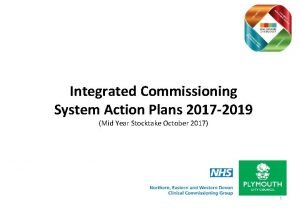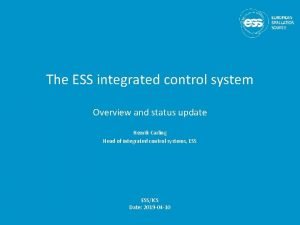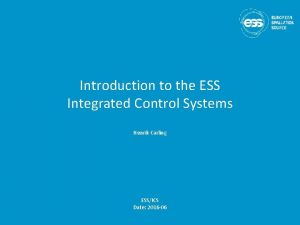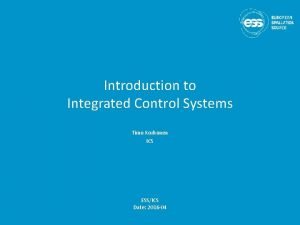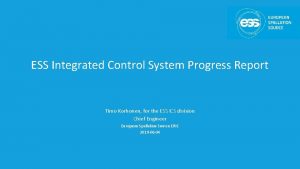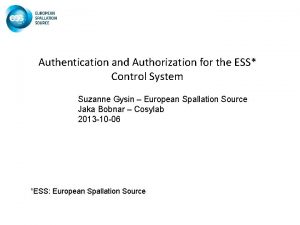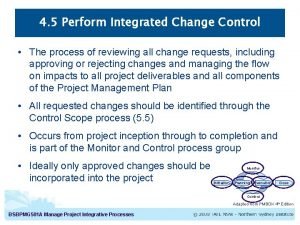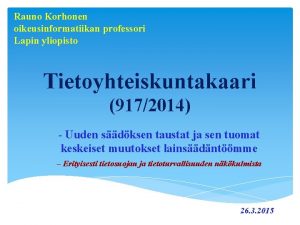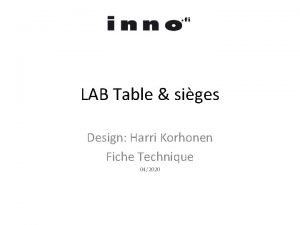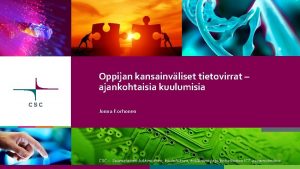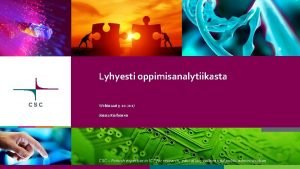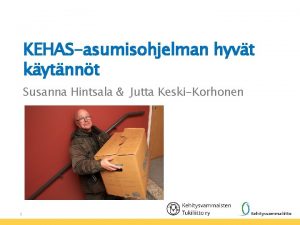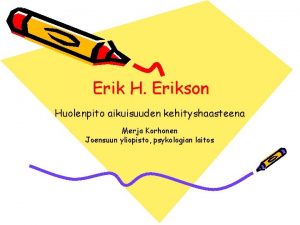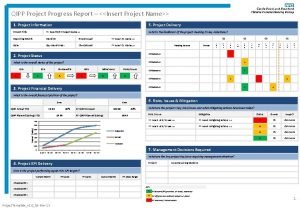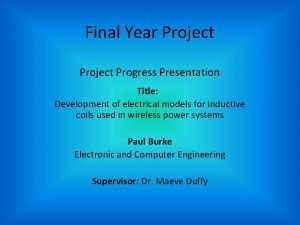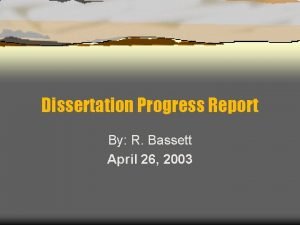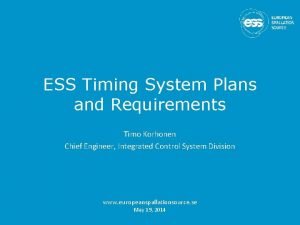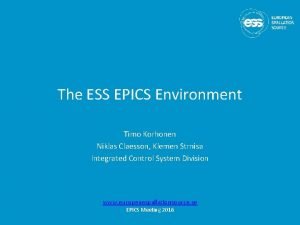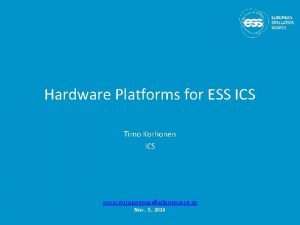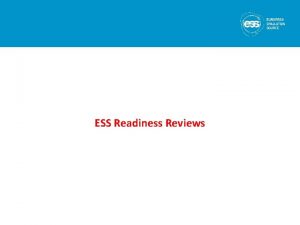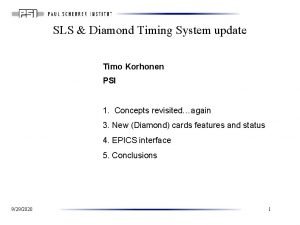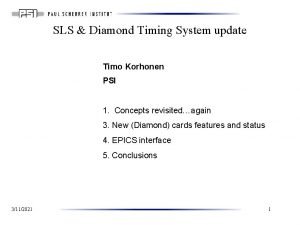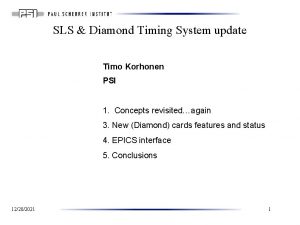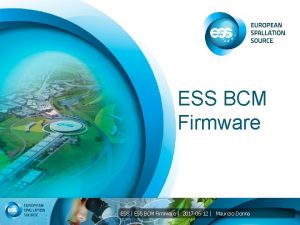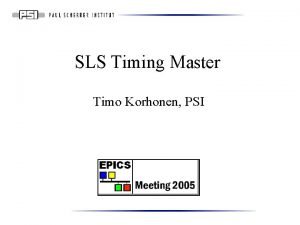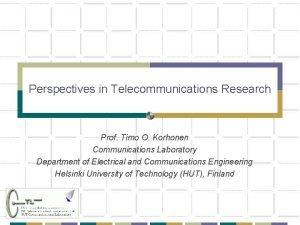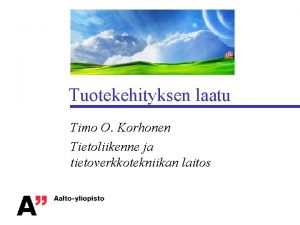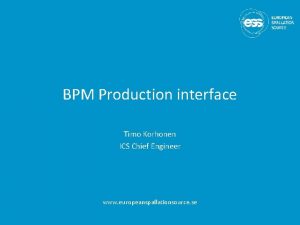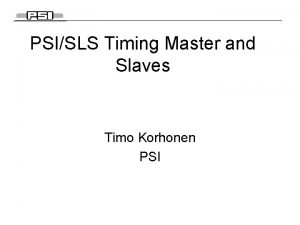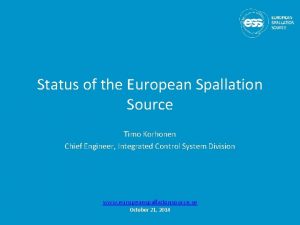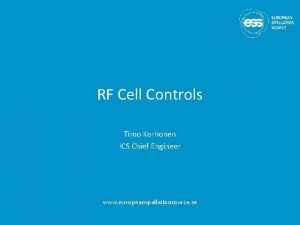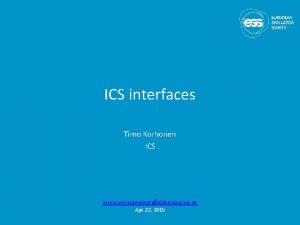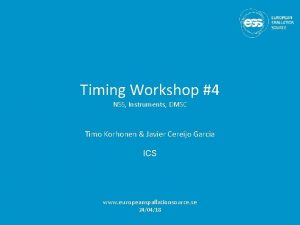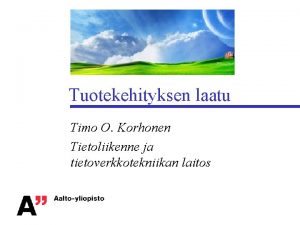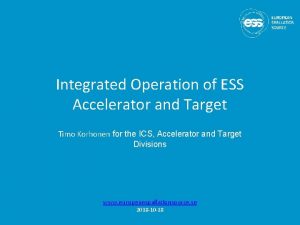ESS Integrated Control System Progress Report Timo Korhonen
























- Slides: 24

ESS Integrated Control System Progress Report Timo Korhonen, for the ESS ICS division Chief Engineer European Spallation Source ERIC 2019 -06 -04

Overview • • Recap of ESS Project status update (pictures) ICS organisation ICS technologies EPICS activities Tools and status About growing pains Summary and outlook 2

The European Spallation Source • ESS is a neutron spallation source for neutron-based multi-disciplinary science. • Neutron scattering can reveal the molecular and magnetic structure and behavior of materials: – Structural biology and biotechnology, magnetism and superconductivity, chemical and engineering materials, nanotechnology, complex fluids, etc. – Often complementary to light sources • The European Spallation Source (ESS) consists of : – a pulsed accelerator that shoots protons into – a rotating metal (tungsten) target to produce neutrons – (up to ) 22 neutron instruments for various experiments • The European Spallation Source (ESS) will house the most powerful proton linac ever built. – When we (one day) reach the specification: one beam pulse has the same energy as a 7. 2 kg shot traveling at 1100 km/hour (Mach 0. 93). 14 times a second. 3

Why is ESS being built? Neutrons for science in Europe 4

The European Spallation Source Artist’s view… 5

ESS Site, a recent aerial photo For some reason always brings to my mind this… 6

Timeline for the ESS facility A few years old picture, just needed a very small update to show that we are still on track. 2067 Decommissioning 2025 ESS construction complete 2014 Construction work starts on the site 2023 ESS starts user program 2009 Decision: ESS will be built in Lund 2019 2012 2003 First European design effort of ESS completed First beam on target ESS Design Update phase complete 7

A lot of equipment arriving and installed… Cryogenic plants delivered, installed and commissioned 8

Commissioning the first parts of the accelerator Temporary Control Room (Final control room will be in target building, not ready yet) Ion Source & Low Energy Beam Transport (ESS, INFN Catania and CEA Paris collaboration) 9

Tunnel installations Waveguides installed in stubs. Many concerns (space, installation, etc. ) but the end result looks quite neat. Cryo distribution lines being installed. The tunnel starts to feel tight… 10

Cool stuff Coldboxes of the cryogenic systems. Cryomodules also start to arrive (first unit) 11

Klystron Gallery installations Klystrons waiting for test and installation. RF Waveguides and loads are being installed 12

Not only RF… Equipment racks installed and populated Pre-assemblies of “linac warm units” with magnets. 13

The massive target station 14

Integrated Control System (division) • Is responsible for all control system integration for – – The accelerator Target station Neutron instruments (up to, but not including experimental data processing) Conventional Facilities integration (water, power, HVAC, etc. ) • Provides EPICS integration for subsystems in all of the above • Provides facility-wide services – Timing system, machine protection, networking, archiving, configuration services, etc. – Also Personnel Protection systems • Is a division in the ESS Machine Directorate (Accelerator, Target) – But also serves the Science Directorate (for neutron Instruments integration) 15

ICS Organization 2019 -05 Employee Consultant Temporary employee Consultant off-site Remy Mudingay Controls infrastructure Benjamin Bertrand Software engineer Johan Christensson Infrastructure technology engineer Stephane Armanet System reliability engineer Alessio Curri System administrator Amir Forsat Anna Gillberg Team assistant Alberto Toral PSS technician Software configuration manager Annika Nordt Protection systems David Sanchez Antoni Simelio MPS engineer Integrator Angel Monera MPS engineer Fernando Carrasco Manuel Zaera-Sanz Faye Chicken Senior engineer MPS Technician Mattias Eriksson Javier Cerejo PSS technician Ph. D Student Stuart Birch John Sparger MPS technician Martin Carroll MPS engineer Morteza Mansouri Hector Novella Susanne Regnell Deputy project manager Evan Foy Emanuele Laface Integrator Accelerator physicist Joao Martins Fredrik Söderberg Integrator Jerzy Jamroz Integrator Julen Etxeberria Saeed Haghtalab Peter van Velze Thomas Fay Yong Kian Sin Integrator Douglas Bezerra Mehdi Mohammednezhad Stephane Gabourin MPS engineer Tomasz Brys Integrator Attila Horvath Szandra Kövecses MPS engineer Paulina Skog PSS documentation expert Meike Rönn PSS documentation expert Integrator Felipe Torres Embedded systems engineer Philippe Rabis Integrator Miklos Boros Integrator Oliver Talevski Juan Esteban Müller Software scientist Ricardo Fernandes Control system software architect§ Karin Rathsman Accelerator scientist Timo Korhonen Chief engineer Banafsheh Hajinasab Software engineer Dirk Nordt Software engineer Georg Weiss Software engineer Jan-Åke Persson Senior software engineer Lars Johansson Software engineer Consultants Embedded systems engineer Ahmed Abujame ICS Installation coordinator Fabio dos Santos Embedded engineer Embedded systems engineer Michael Beck Johannes Kazantzidis Gabriel Fedel Work package manager Integrator Maria Romedahl Nicklas Holmberg Wojtek Fabianowski Integrator Software engineer Technician Work package manager Technical coordinator Claudio Rosati Jeong Han Lee Viktor Fred Integrator Controls Software engineer Junior controls engineer MPS engineer Systems engineer Integrator Open position MPS engineer Thilo Friedrich Senior engineer PSS senior technican Johannes Gustafsson FPGA Engineer Joakim Söder Electrical engineer PSS engineer Peter Holgersson Samuel Crossland Karl Vestin Hardware and integration Enric Bargalló Te-Hung Tsen PSS industrial automation Division head Denis Paulic Junior devops engineer Open position Henrik Carling DGL, PSS engineer Network reliability engineer Anders Harrisson Position under consideration Work unit manager Marino Vojneski Integrator Consultants ∑=84 ESS-0081625

Control system overview This is roughly the scope of ICS 17

Three layer strategy - control systems hardware at ESS Signal speed 10 MHz 100 k. Hz Digital controls platform Micro. TCA boards with a powerful FPGA. A FPGA framework constitutes the development environment. The CPU board runs EPICS 10 k. Hz • ICS has adopted a three layer strategy for implementing the control system based on signal speed – A custom made platform based on micro. TCA for applications with data acquisition exceeding 100 k. Hz – Fast data processing happens in FPGA, augmented by ample CPU power. Timing included in every system. 1 k. Hz 100 Hz Ether. CAT 10 Hz Slower signals are handled by industrial automation (PLC) for reliability and cost reasons. The standardized platform for ESS applications comes from Siemens 1 Hz 0. 1 Hz Ether. CAT I/O modules that are connected to commercial or opensource Ether. CAT master controllers which are in turn connected to EPICS – For slower signals, Ether. CAT will be used as a real-time fieldbus with good price/performance ratio – Synchronization and event information are key for applications where a full custom platform solution would be too costly – Low speed signals are handled with commercially available PLC systems from Siemens – This is a cost-effective solution that addresses ESS reliability and maintainability requirements – The PLCs will be connected to EPICS for further integration into the control system Industrial automation (PLC) 18

Software components/tools/services • EPICS, of course • Archiving: Archiver Appliance • Control System Studio – Display Builder, etc. – Going for Phoebus (replacing Eclipse RCP) • Channel Finder – Starting to put this in real use – now that we have hardware to control • Open. XAL for accelerator physics modelling • Calibration service – Handling of unit conversions – measurement data to conversion coefficients • Actual conversion happens in the IOC (obviously) • Configuration management tools (databases, EAM) • Logbook • Etc. 19

EPICS at ESS • Committed to use EPICS 7 with pv. Access fully throughout the facility – IOCSs, even 3. 15 are equipped with PVA modules • even if people often forget this…education needed. • More education needed to start using the new features – this is underway – All tools support pv. Access • • • CS-Studio tools all support PVA Archiver Appliance can archive Normative Types Channel Finder supports PVA Open. XAL (our accelerator physics code) has (basic) PVA support built-in pva. Py is our official Python interface • Supported EPICS versions in our (E 3) environment, as of now – Base 3. 15. 5 / 3. 15. 6 – Base 7. 0. 1. 1 / 7. 0. 2. 1 20

EPICS activities at ESS – Community and internal • Development and deployment tools (Thursday talk on “E 3”) • Control System Studio – Display Builder, etc. Active participation in development group • EPICS 7 development - support – Funding projects to support developments in EPICS Core • Project funds will not last forever, though… – ESS Developers working on core technologies (pv. Access) – We plan to organize a “Documentathon”, in ~August this year • To address documentation “debt” that has accumulated • Please consider joining if you would like to contribute – for your own or the community’s sake 21

Configuration Tools • Like every self-respecting EPICS project, we also have ambitious configuration tools – CCDB (Controls Configuration Database), Cable. DB – IOC Factory, PLCFactory • While there are challenges with these tools, I keep claiming they will eventually pay off, provided that: – We keep our expectations realistic – Tools will only get us so far; do not even try to fully cover the EPICS setup – Do not let the tools limit use of EPICS good features • Herein lies the biggest challenge – EPICS database is a programming tool. Auto-creating algorithms is still beyond our skills. • Jury is still out. Final verdict will be in a few years – But “IOC management by emacs” is not going to be realistic either… 22

Growing pains Building up a new lab from the ground… • Steep learning curve, project-wide – Most of the project staff is building their first accelerator – and a big one – Many different backgrounds – people have to learn to work together • Complicated project setup – Many in-kind activities to be supported and followed up, and finally integrated • Staff increase has been really fast – Which is a good thing but not unproblematic • EPICS “awareness” – Not many people know EPICS when they start at ESS – Available possibilities of EPICS and related tools not realized or utilized – or even misunderstood. • First commissioning experience has started to bring the teams together – In ICS but also (and more importantly) from different organizations. 23

Summary and outlook • ESS has become an accelerator lab – from a paper lab. Real beam, real issues. • ESS, including ICS division has grown very rapidly. With its pros and cons. • Hardware is appearing at the site, at a growing speed – Nice but sometimes very hectic. • We are still on the learning curve in many issues – But situation is constantly improving – even if we tend to forget it. • ESS has a strong will and commitment to work with the community – But (even) our resources are limited – we need the community to reach our goals. • Next couple of years will be very busy – but exciting! 24
 Mtca psu
Mtca psu Difference between status report and progress report
Difference between status report and progress report Integrated commissioning and progress system
Integrated commissioning and progress system Physical progress and financial progress
Physical progress and financial progress Ess in control system
Ess in control system Henrik carling
Henrik carling Ess control system
Ess control system Ess control system
Ess control system Ess control system
Ess control system Perform integrated change control process
Perform integrated change control process Jenni korhonen
Jenni korhonen Rauno korhonen
Rauno korhonen Annikki korhonen
Annikki korhonen Korhonen courant
Korhonen courant Geminisynnytys
Geminisynnytys Jonna korhonen
Jonna korhonen Jonna korhonen okm
Jonna korhonen okm Jutta keski-korhonen
Jutta keski-korhonen Mimosa sihvola
Mimosa sihvola Eriksonin kehitysteoria
Eriksonin kehitysteoria Qipp agenda
Qipp agenda Ecd progress report
Ecd progress report Fyp progress report
Fyp progress report Dissertation progress report yale
Dissertation progress report yale Supervisor
Supervisor
